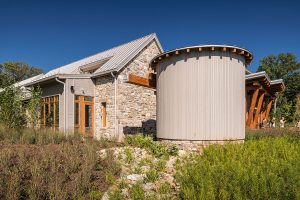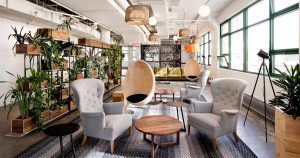July Forum Recap: Certified Living – Living Building Challenge
September 2, 2018
By Jennifer Urrutia July’s GreenHomeNYC forum featured Casey Cullen-Woods, Project Director from Thornton Tomasetti and Co-Founder and Co-facilitator of NYC Living Future Collaborative, and Megan Bové, Project Manager from Vidaris. These two presenters are well versed in the Living Building Challenge standard. Both presenters have worked on notable projects such as the Willow School (Living Certified v2.0) in New Jersey and the Etsy Headquarters (Petal Certified 3.0) in Brooklyn. During their presentations, both Cullen-Woods and Bové highlighted the importance of using healthy building products as well as the need to embrace a connection to the natural environment through building design.
Flowers are the metaphor the International Living Future Institute uses to guide the design and performance goals for regenerative building design. “Petals” are the categories a project must consider to reach Living or Petal certification. The petals are: Place, Water, Energy, Health+ Happiness, Materials, Equity, and Beauty and they were the guiding principles structuring the outline from the presenters.
July’s GreenHomeNYC forum featured Casey Cullen-Woods, Project Director from Thornton Tomasetti and Co-Founder and Co-facilitator of NYC Living Future Collaborative, and Megan Bové, Project Manager from Vidaris. These two presenters are well versed in the Living Building Challenge standard. Both presenters have worked on notable projects such as the Willow School (Living Certified v2.0) in New Jersey and the Etsy Headquarters (Petal Certified 3.0) in Brooklyn. During their presentations, both Cullen-Woods and Bové highlighted the importance of using healthy building products as well as the need to embrace a connection to the natural environment through building design.
Flowers are the metaphor the International Living Future Institute uses to guide the design and performance goals for regenerative building design. “Petals” are the categories a project must consider to reach Living or Petal certification. The petals are: Place, Water, Energy, Health+ Happiness, Materials, Equity, and Beauty and they were the guiding principles structuring the outline from the presenters.
The LBC standard is comprised of three levels of certification: Certified Living, Petal Certified and Zero Energy Building certification. Achieving all seven petals earns the building a Living Certified achievement. Achieving three of the seven petals earns a buildingPetal Certification. In order for projects to attain Petal Certification, buildings must successfully implement one of the three following petals: Water, Materials or Energy.Petal Certification is monitored for months preceding occupancy to prove that achievement was met. The final type of certification is Zero Energy Building Certification, which certifies a building is demonstrating zero energy performance.
 The Willow School Health Wellness and Nutrition Center, which Cullen-Woods helped to certify, achieved a Certified Living certification by incorporating strategies such as rainwater harvesting, a low energy wetland wastewater treatment system, and net positive energy through photovoltaic panel array. Additionally, the building incorporated biophilic elements into its design, by using the natural environment surrounding the school as inspiration for different design features throughout the building. Read more about how this innovative project achieved Certified Living on the International Living Future Institute website.
The Willow School Health Wellness and Nutrition Center, which Cullen-Woods helped to certify, achieved a Certified Living certification by incorporating strategies such as rainwater harvesting, a low energy wetland wastewater treatment system, and net positive energy through photovoltaic panel array. Additionally, the building incorporated biophilic elements into its design, by using the natural environment surrounding the school as inspiration for different design features throughout the building. Read more about how this innovative project achieved Certified Living on the International Living Future Institute website.
 Bové, who helped The Etsy Headquarters achieve Petal Certification, described how healthy building materials are important for impactful design. The EtsyHeadquarters paid specific attention to the products used throughout the building, by ensuring that all materials used were not composed of any harmful or toxic chemicals. In addition, a majority of the products used have Declare labels, which clearly state the source, composition and end of life use of the product.The project also used only salvaged, reused of FSC (Forest Stewardship Council) certified wood throughout the building. Discover more about the EtsyHeadquarters regenerative features on the International Living Future Institute website.
Bové, who helped The Etsy Headquarters achieve Petal Certification, described how healthy building materials are important for impactful design. The EtsyHeadquarters paid specific attention to the products used throughout the building, by ensuring that all materials used were not composed of any harmful or toxic chemicals. In addition, a majority of the products used have Declare labels, which clearly state the source, composition and end of life use of the product.The project also used only salvaged, reused of FSC (Forest Stewardship Council) certified wood throughout the building. Discover more about the EtsyHeadquarters regenerative features on the International Living Future Institute website.
Both presenters highlighted the key characteristics of successful projects. They explained that companies who tend to be successful in achieving LBC certifications are pioneers whose brand fits the program intent and who strive to be among the first to carry out LBC’s net positive mission.
Photo credits: International Living Future Institute, courtesy of Robert Faulkner Etsy